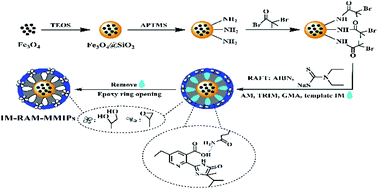Highly selective enrichment and direct determination of imazethapyr residues from milk using magnetic solid-phase extraction based on restricted-access molecularly imprinted polymers†
Abstract
Restricted access media magnetic molecularly imprinted polymers (RAM-MMIPs) were prepared as magnetic solid phase extraction (M-SPE) material by reversible addition fragmentation chain transfer (RAFT) technique. The resulting RAM-MMIPs had a uniform, imprinted, hydrophilic layer (63 nm), good binding capacity (34.85 mg g−1) and satisfactory selectivity. In addition, these RAM-MMIPs had a robust ability to eliminate the interference of protein macromolecules. These RAM-MMIPs were then coupled with HPLC/UV to identify imazethapyr (IM) residues in untreated milk samples. Several major factors would affect M-SPE extraction efficiency, such as the amount of RAM-MMIPs, pH, extraction time of the sample solution, and the volume ratio of the elution solvent. Under the optimal conditions, the developed method had good linearity (R2 > 0.9993), low detection limit (2.13 μg L−1), and low quantitative limit (7.15 μg L−1). These results indicated this proposed approach is an efficient method for direct enrichment and detection of IM herbicides in milk and other biological samples.

- This article is part of the themed collection: Advanced Separation


 Please wait while we load your content...
Please wait while we load your content...